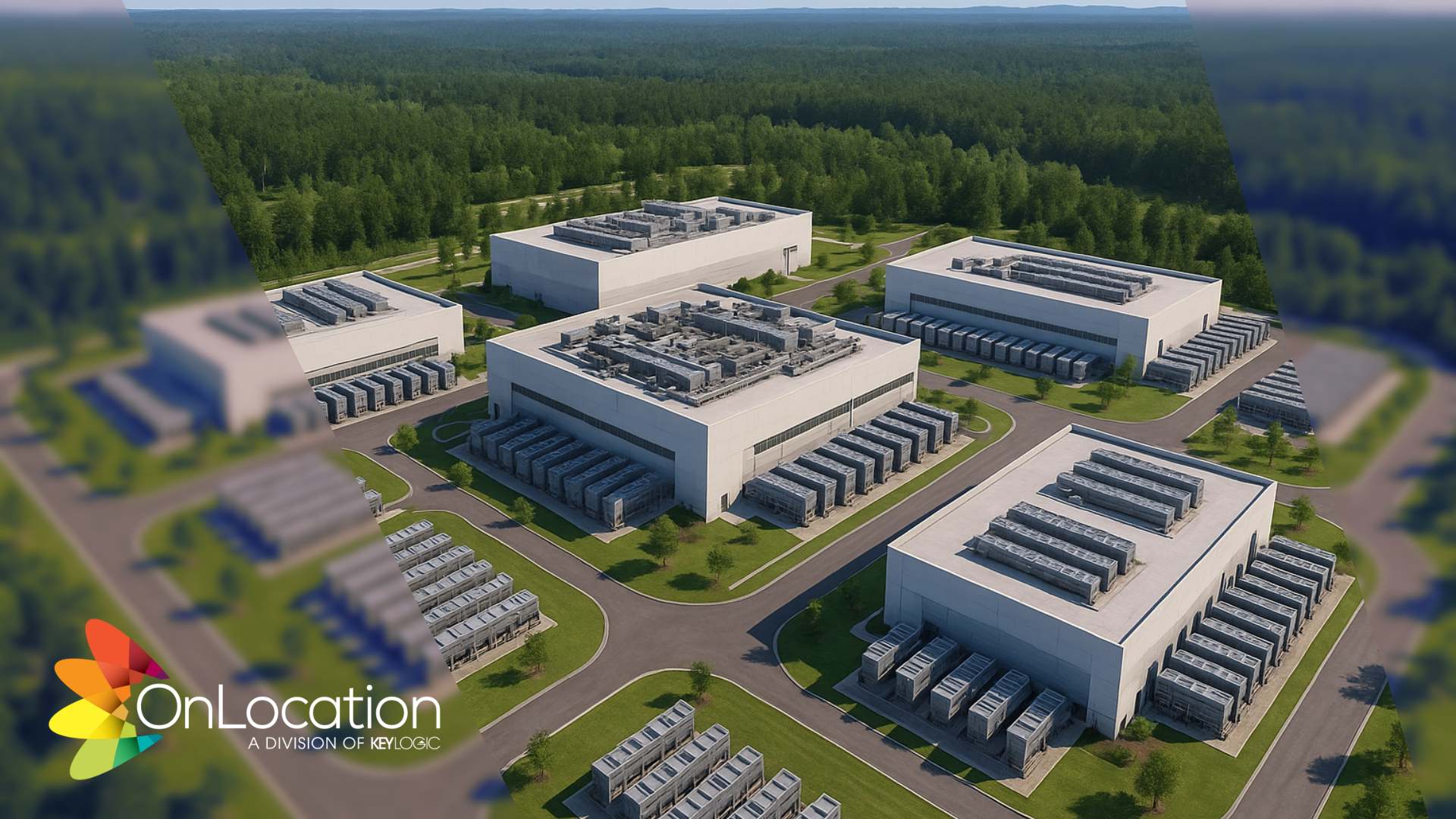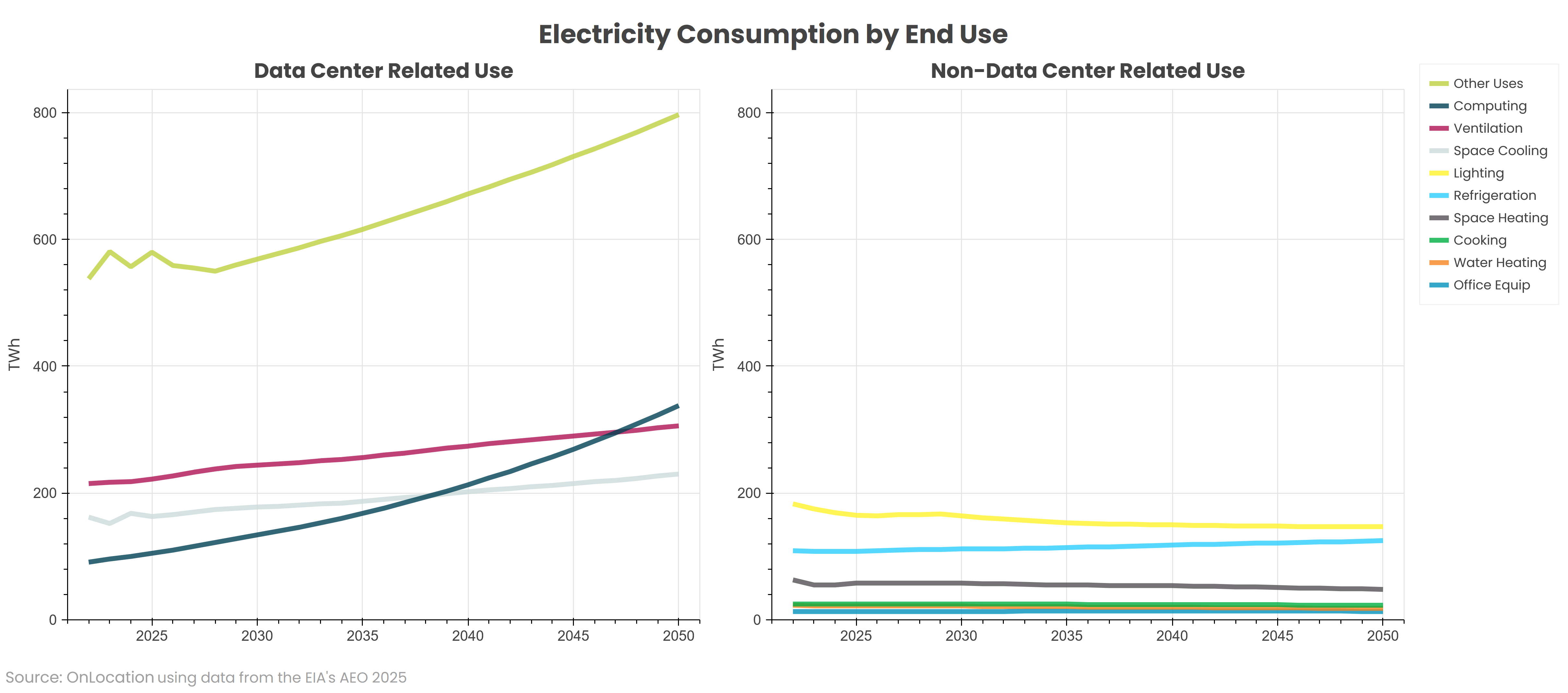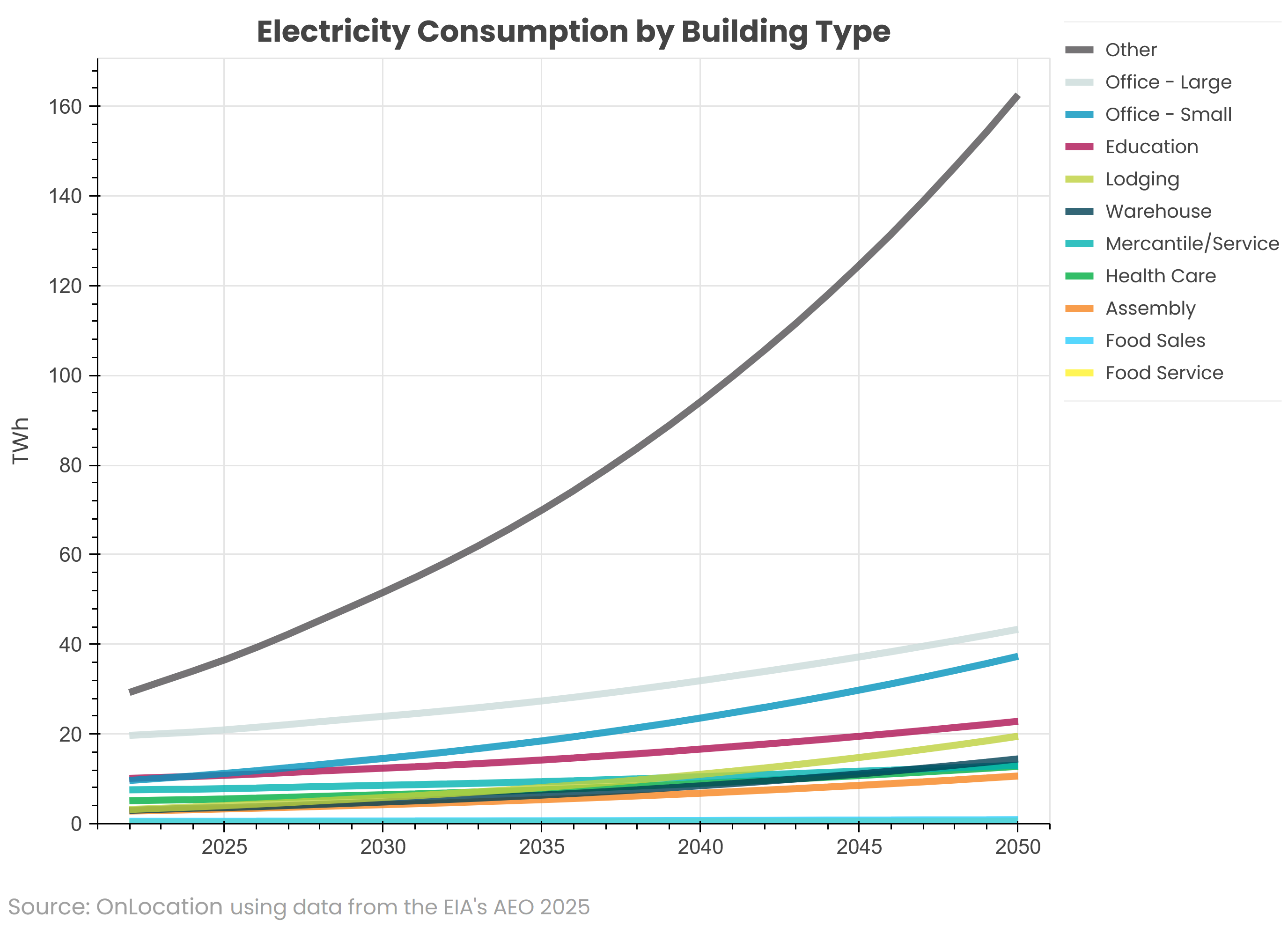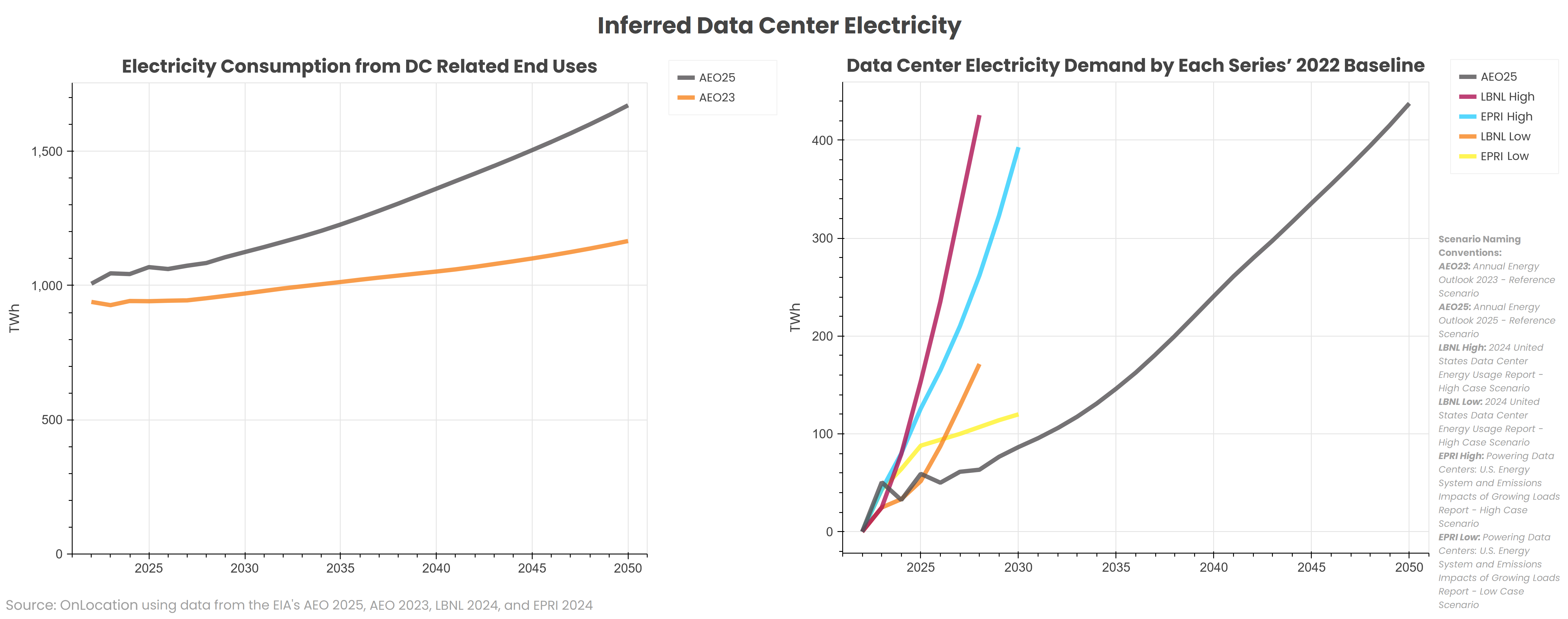
AEO 2025 Trends: Growing Electricity Demand from Data Centers
Artificial intelligence (AI) is no longer a distant frontier. It’s a defining feature of today’s economy, and a growing driver of energy demand. Since the public release of OpenAI’s ChatGPT in late 2022, the rapid advancement and adoption of generative AI has spurred a major wave of investment in U.S. data centers, the digital infrastructure that powers everything from cloud computing to large-scale AI model training.
The federal government is actively shaping policy to support this growth. Shortly after taking office in January 2025, the current administration issued an executive order prioritizing the deployment of advanced nuclear reactors to provide reliable, low-carbon energy for critical AI data centers. Building on this policy direction, the Department of Energy announced a Request for Information in April 2025, seeking input on leasing federal lands, including DOE-managed sites, specifically to facilitate AI data center development and associated energy infrastructure. These coordinated federal actions clearly recognize data centers and the necessary supporting energy infrastructure as strategic priorities.
The U.S. Energy Information Administration (EIA) released the Annual Energy Outlook 2025 (AEO 2025) in April, featuring significant updates to how data centers are represented in long-term energy projections. This is the fifth blog posted in OnLocation’s weekly “AEO 2025 Trends” series that highlights key results and insights which our experts have gained from the latest AEO scenarios. OnLocation has decades of experience in the application and enhancement of NEMS for its clients and can offer a unique perspective for interpreting the AEO results.
Highlighting the transformative impact of AI, a recent EIA blog notes that electricity use from commercial computing could surpass space cooling and ventilation in commercial buildings by midcentury. Given their growing importance, we first explore how much data center electricity demand is embedded in AEO 2025 and subsequently we address broader implications for modeling data centers amid the inherent uncertainties of this rapidly evolving sector.
Data Centers Are Embedded Across End Uses and Building Types in AEO 2025
AEO 2025 makes notable changes to the Commercial Demand Module of the National Energy Modeling System (NEMS), the framework used by EIA to develop the AEO. These changes reflect the sharp growth in computing loads tied to data centers, particularly for AI. Two figures help illustrate the impact.

Figure 1. Commercial Electricity Consumption by End Use
Figure 1 shows projected electricity consumption by end use in commercial buildings in the AEO 2025 Reference case. The left panel focuses on data center-related end uses: computing, space cooling, ventilation, and a residual “other” category. From 2022 to 2050, all four end uses grow by more than 40 percent, with computing increasing the most at 270 percent. However, these end-use categories are not exclusive to data centers. For example, the “other” category includes a broad range of miscellaneous building and non-building electricity uses—from elevators to water services and streetlights—beyond equipment. Similarly, not all computing, cooling, or ventilation loads are attributable to data centers. The right panel underscores how much these categories stand out compared to relatively flat trends in other commercial end uses, even though they reflect broader electricity consumption patterns, not just data centers.
Figure 2 turns to building types which are represented in NEMS by commercial floorspace. On-premises data centers, housed within facilities like office buildings, are considered part of their services across multiple building types. Standalone data centers, on the other hand, are included as part of the broad “Other” category, which rises rapidly to account for 48 percent of all commercial building electricity demand in 2050, a reflection of their outsized role in projected growth. Data centers are not treated as their own building type given the limited data available from the 2018 Commercial Buildings Energy Consumption Survey, as described by EIA in their data center pilot study.

Figure 2. Commercial Electricity Consumption by Building Type
In short, AEO 2025 embeds data center electricity demand across two dimensions: by end use and by building type. But it does not report a single, direct estimate, due to the underlying data uncertainties.
Estimating the AI-Driven Demand in AEO 2025
To understand how much data center demand is reflected in AEO 2025, we use a simple counterfactual approach. AEO 2023, released before the recent AI boom and before the data center related modeling updates were introduced, provides a useful baseline, effectively a “no-AI growth” scenario. While AEO 2023 includes some data center demand, it reflects pre-AI trends and assumptions.
By comparing AEO 2025 and AEO 2023 Reference cases, we can estimate the additional electricity demand driven by post-2022 AI developments. To control in part for other changes, such as the model updates in base year commercial floor space, we focus on incremental electricity use relative to the 2022 baseline.
Figure 3 presents this comparison. The left panel shows total commercial electricity use from data center-related end uses (computing, cooling, ventilation, and others) in both AEO 2023 and AEO 2025. The AEO 2025 projection is higher starting in 2022, and the gap widens over time. We infer that this difference primarily represents data center demands.

Figure 3. Inferred Data Center Electricity
To place our results into context, we compare them with credible external benchmarks and isolate the effect of recent AI developments. The right panel does this by showing the inferred incremental growth from the 2022 level embedded in the AEO 2025 results with estimates from the LBNL, and EPRI reports. By subtracting the 2022 value from each series, we can directly compare their growth trajectories.
In AEO 2025, electricity use from data center-related end uses is projected to increase approximately 90 TWh by 2030 and reach 440 TWh above the 2022 baseline by 2050. These levels are substantial but land on the conservative side compared to the LBNL projections, especially in the near term.
Of course, this is a rough estimate. It’s based on a straightforward subtraction across two vintages of AEO. Many variables change between the two outlooks, and isolating AI-specific impacts in a model as complex as NEMS is inherently imprecise. But it gives us a window into how EIA’s energy outlook now reflects this fast-growing load.
Looking Ahead: Data Center Modeling Is Just Beginning
AEO 2025 has significantly updated the representation of data centers, embedding their electricity demand across multiple end uses and building types. As a result, directly quantifying data center demand is challenging. Our quick analysis, using AEO 2023 as a “no AI growth” counterfactual, points to AI-driven growth adding roughly 90 TWh by 2030 and 440 TWh by 2050 in commercial electricity use, a projection that appears conservative relative to other available estimates.
Most of the critical questions about data centers and related energy infrastructure, however, require detailed scenario analyses due to inherent uncertainties in demand projections. The rapid advancement of foundational AI models and the diverse use cases driving their adoption create substantial unpredictability. Adding complexity, there is also the dynamic interaction between hyperscale data center providers pushing to accelerate their deployment schedules (the “speed to power”) and regional power markets, each with their distinct resource profiles and regulatory environments.
Effectively addressing these nuanced questions requires the capability to implement customized alternative demand trajectories at regional levels. At OnLocation, we have been actively enhancing our analysis of data center dynamics since 2024 through targeted augmentations of the NEMS model. We have published our insights in the White Paper, “Data Center Demands and Impacts on the Energy System,” along with a recent update reflecting new energy policy developments. Our ongoing work continues to expand modeling capabilities, including detailed regional projections of data center growth, alternative load shapes to capture the nearly 24/7 energy use in data centers, evaluations of microgrid integration to power these facilities, and assessments of emerging firm power technologies such as enhanced geothermal and small modular reactors (SMRs) that are gaining attention by developers. Our OnLocation experts welcome collaboration and conversation as the industry works to understand and respond to the evolving footprint of AI and data center energy use.
For more insights into the AEO 2025 scenario results, see the recent blogs in our AEO 2025 Trends series including Powering Future Demand, Grid Reliability and Critical Materials, Driving Transportation Policy Change, and Oil and Gas Supply, as well as our initial AEO 2025 overview blog posted soon after the AEO release in April.

